“I still remember the moment in January 1991 when I received the journal ‘High Voltage Apparatus’, which published my first academic paper. Holding the journal in my hands, inhaling the ink’s fragrance, it marked the breakthrough from 0 to 1 in publishing my paper. At that time, the types of journals were limited, and the publication volume was low. It was quite rare for a graduate student to publish a paper. This paper set sail for my academic research and strengthened my belief and determination to continue progressing on the path of scientific research.” Professor He Jinliang stated that his research can be divided into two phases: addressing the technical requirements of overvoltage protection in power transmission and transformation systems and exploring the forefront of power basic materials to achieve technological leadership. His research journey vividly reflects the spirit of relentless self-improvement, overcoming challenges, and daring innovation among researchers during that era.
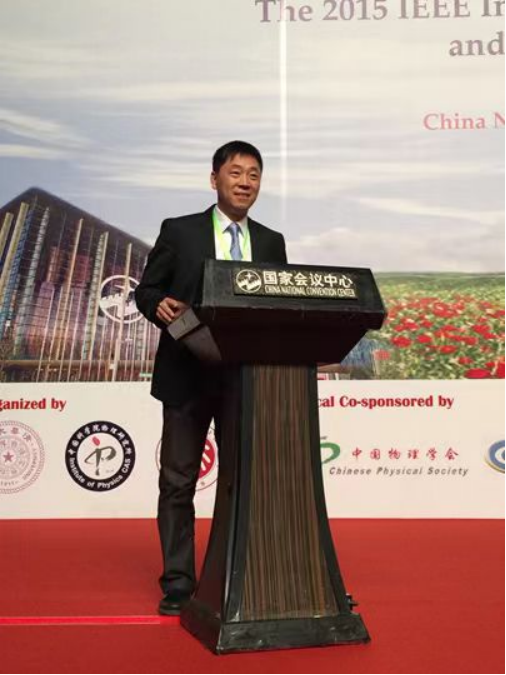
As the conference chair, presided over the 2015 International Conference on Magnetism
In the early 1990s, as China’s national economy grew rapidly, it also drove the high-speed development of the national power grid. However, transient large currents and high voltages generated by lightning strikes, short circuits, and other factors led to about 40%-60% of power grid outage faults. This posed a challenging difficulty for the safety of power transmission and transformation systems. Overvoltage protection, including lightning protection, was a global scientific research challenge faced by power grids worldwide, and it was at the forefront of lightning physics. Professor He Jinliang and his research team addressed this challenge by establishing three lines of defense for power system overvoltage protection, focusing on the safe release of large currents, deep suppression of high voltages, and rapid monitoring of transient faults.
Rooted in Lightning Grounding — Solving a Global Challenge with Explosive Reduction of Resistance
The grounding system is an indispensable component of the power grid and a cornerstone for ensuring the safe operation of power systems. In the 1990s, there was a lack of understanding of the lightning dissipation characteristics in both domestic and international settings, making effective calculation and protection challenging. Professor He Jinliang used ground X-ray imaging technology to make lightning dissipation in the ground “visible”. For the first time, he obtained clear images and development processes of lightning ground discharge, established the mesoscopic breakdown theory of soil, and developed a transient characteristic calculation method for grounding systems that considers the variable characteristics of soil mesoscopic discharge and the macroscopic frequency-dependent characteristics of soil parameters. Simultaneously, through research, he discovered the effective discharge length of ground conductors and the effective discharge area of the grounding grid under lightning action, improving the lightning protection effectiveness while significantly reducing the dimensions of lightning protection grounding devices, thereby reducing the occupied area. These research efforts achieved a fundamental theoretical breakthrough from unclear cognition to precise calculation of lightning dissipation characteristics. The proposed formulas for calculating lightning impact grounding resistance and effective grounding discharge length were adopted by China’s national grounding standards and recognized by important international organizations and guidelines in the field of international electrical engineering, including IEC, ITU, CIGRE, and IEEE.
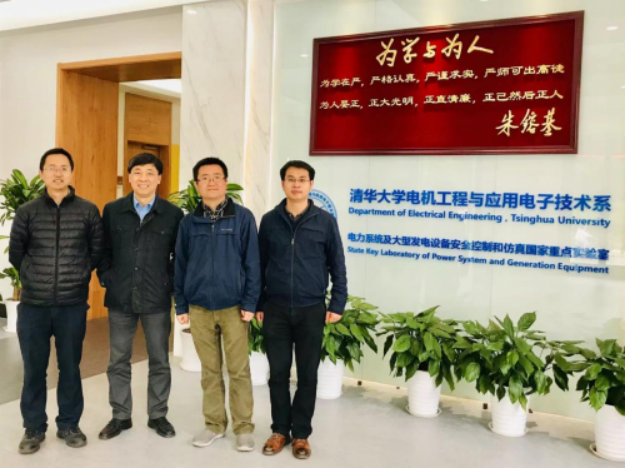
Group photo with young scholors
As China’s economy developed rapidly, land resources became increasingly scarce, and numerous substations had to be built in geologically harsh areas. In the event of a short circuit accident at a large substation, poor grounding could lead to equipment damage and personal safety incidents. Grounding resistance is a crucial indicator for assessing the safety of substation grounding systems. China had long relied on expanding the area of the grounding grid to reduce grounding resistance, and for instance, the Fuzhou UHV substation required a 7-square-kilometer grounding grid to meet standards. In the face of this challenge of effectively reducing resistance in high-resistivity rock and soil areas, which was a global problem, Professor He Jinliang proposed the idea of constructing a “root system” with low resistivity in the ground. Inspired by the massive root system of large trees in the ground, he suggested building deep holes in the ground, using explosive technology to create cracks in rock walls, expanding crack lengths through the “air blade effect,” and then injecting low-resistance filling materials into the cracks to form low-resistance drainage channels. After conducting over a thousand experiments, he obtained optimal blasting techniques for different geological areas. The crack radius could reach up to 40 meters, reducing the equivalent resistivity of rock and soil within a hundred meters deep by two orders of magnitude. Ultimately, a three-dimensional drainage network of ground dissipation was formed around the grounding system. The explosive grounding technology solved the problem of grounding resistance in power engineering in hundreds of areas with adverse geological conditions in China’s power grid. Additionally, he proposed a multi-scale electromagnetic field calculation method for wide and complex geological areas, achieving accurate calculation of the dissipation characteristics of large-scale three-dimensional grounding systems. This allowed targeted reduction of grounding resistance in complex ground systems. The explosive grounding technology broke through the world’s technical challenge of grounding resistance reduction in high-resistivity rock and soil areas that had long plagued power systems. It was evaluated by global experts as the “most effective resistance reduction technology” and was included in the “High Voltage Engineering” textbook by Ohio State University in the United States.
The achievements of Professor He Jinliang’s team in lightning protection and grounding technology have not only been widely applied in power systems but have also extended to industries such as communications, petrochemicals, and major national projects like the Qinghai-Tibet Railway and Olympic venues. In 2010, he was honored with the “Technical Achievement Award” by the IEEE Electromagnetic Compatibility Society for his outstanding contributions to lightning protection and grounding technology in power systems.
Breaking Key Technologies of Surge Arresters — Solving the Challenge of Deep Voltage Suppression in Power Grids
Surge arresters limit high voltages by absorbing energy, safeguarding the safety of power grid equipment. The core is a varistor valve core made of metal oxide. In the 1980s, China introduced technology from Japan, but the advanced valve core formula was always restricted, leading to poor protective performance of domestically produced surge arresters. Particularly with the comprehensive construction of China’s UHV system, there was an urgent need to improve the performance of surge arresters for deep voltage suppression, enhance the safety of UHV systems, and achieve economic construction of UHV systems. During his work at the Korea Electrotechnology Research Institute from 1997 to 1998, Professor He Jinliang encountered the preparation technology of varistor valve cores. After returning to China, he spent more than twenty years innovating the research paradigm of arrester materials. He first established models, analyzed possible formulas affecting the performance of varistor valve cores, and directed targeted research through extensive experimental studies. The team proposed a multi-element rare earth-doped varistor valve core material formula system, achieving a breakthrough in high-end arrester materials. The key performance parameters of the developed varistor valve core, including high voltage gradient, low residual voltage, and large current flow, surpassed the products of Toshiba Corporation, representing the international best level. This addressed the challenge of deep voltage suppression in the face of lightning and electromagnetic transient events, as well as the difficulty of hundred-megajoule energy absorption in China’s UHV system. Compared to traditional lightning arresters, the developed high-performance lightning arrester can reduce lightning and operational overvoltages in ultra-high voltage systems by about 30%, significantly enhancing the safety of the power grid. It also substantially reduces the insulation strength requirements, manufacturing difficulty, and construction costs of extra-high voltage equipment, providing crucial support for the economic development of extra-high voltage systems. Additionally, as one of the pioneers internationally, he invented the fully solid-insulated composite outer casing arrester, eliminating the explosion hazards of traditional porcelain casing arresters. Simultaneously, this innovation allows the arrester to be used for lightning protection on transmission lines rather than just in substations. Proof of the effectiveness of the developed arrester is seen in over 300,000 operating arrester units in China, demonstrating that arrester units on power lines can eliminate lightning-induced faults in the protected line segments by 100%. Furthermore, the high-performance valve plates developed have been extensively applied in lightning protection for China’s high-speed trains and 5G base stations, achieving domestic substitution with performance surpassing similar products from foreign companies. What is most gratifying for him is that in 2013, Professor He Jinliang was awarded the 6th Hoshino Prize by the Electrical Equipment Association of Japan, the birthplace of lightning arresters, in recognition of his significant international contributions in the field of lightning arresters.
Overcoming Micro Power Sensors to Facilitate Comprehensive Monitoring of the Power Grid
Since 2009, China has officially initiated the Smart Grid Project, with one of its core components being the integration of distributed sensing technology with the power grid to rapidly eliminate faults such as lightning strikes and short circuits. After extensive discussions, Professor He Jinliang focused on the new field of power sensors, particularly micro-current sensors and voltage sensors. The current in the power grid can reach hundreds of thousands of amperes, the voltage can go up to millions of volts, and the frequency ranges from direct current to hundreds of megahertz. Traditional techniques face challenges in meeting the monitoring requirements for wide-frequency, high-current, and high-voltage conditions in the power grid. He proposed using the tunneling magnetoresistance effect to realize wide-frequency current measurement, and successively overcame key technologies such as sensor chip design and performance control, achieving independent manufacturing of magnetic field sensor chips. For voltage measurement, the team also invented electric field sensors based on piezoelectric resistance, photoelectric coupling, and other effects. They developed a series of sensors with frequencies ranging from direct current to hundreds of megahertz, currents ranging from hundreds of microamperes to hundreds of kiloamperes, and voltages reaching millions of volts. By deeply integrating sensors with power lines and equipment, they achieved comprehensive monitoring of the power grid and rapid identification and location of faults. Micro power sensors have become a crucial core foundation for real-time monitoring and the intelligent transformation of the power grid, providing key technical support for the construction of a new type of power system. The technology and achievements of sensors in the intelligent transformation of the power grid won the 2022 Engineering Technology Innovation Award from the Institution of Engineering and Technology in the United Kingdom, with the evaluation that this technology represents a “leap-forward breakthrough toward a smart grid.”
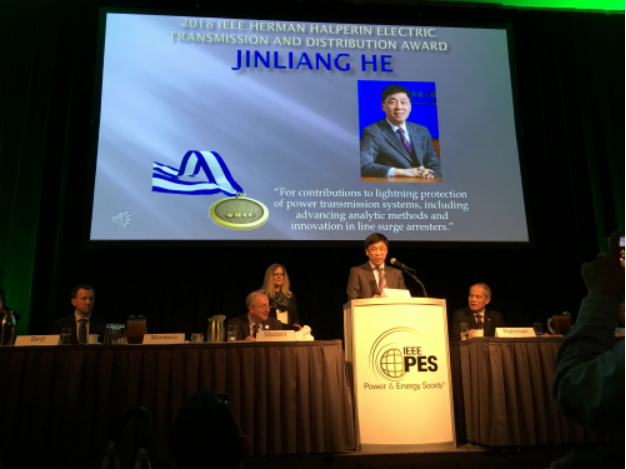
IEEE Herman Halperin Award Presentation and Award-winning Speech
Professor He Jinliang’s research achievements in the field of overvoltage protection technology in power systems have been successfully translated into practical applications. His work has propelled technological innovation and industrial upgrading in lightning protection grounding technology, lightning arrester technology, and sensing technology in China. This has resulted in significant economic and social benefits. Professor He has received two national second prizes for scientific and technological progress and one national second prize for technological invention. He has also been honored with the China Electric Power Outstanding Contribution Award. The accomplishments of Professor He Jinliang and his team have gained high recognition from international academic organizations. In 2017, he was elected as the Chairman of the Executive Committee of the Asia-Pacific International Conference on Lightning (a permanent institution). In 2018, he was granted the prestigious IEEE Herman Halperin Award in the field of power transmission and transformation. He became the first Chinese scholar to receive this award in its 59-year history. The IEEE citation praised, “He Jinliang’s innovative analytical methods and protective equipment ensure a safer and more reliable power transmission and distribution system.” Reflecting on his election as a Foreign Corresponding Member of the Bologna Academy of Sciences, one of the world’s oldest scientific academies, in 2022, Professor He Jinliang remarked, “This is not just an honor; it signifies the international recognition of my research work over the years by peers worldwide.”
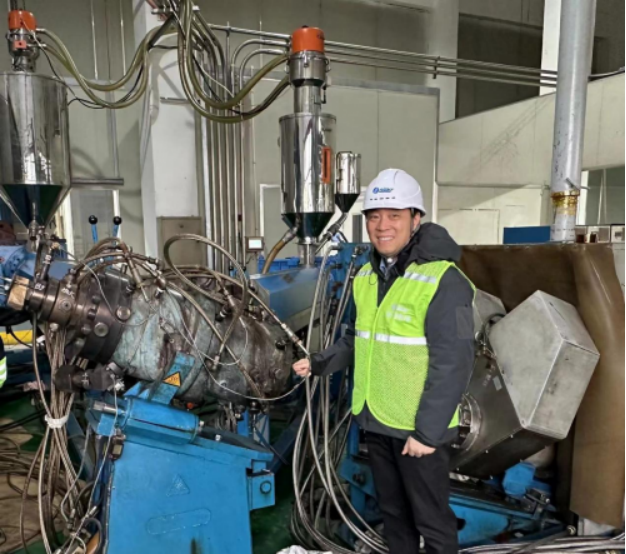
Professor He Jinliang guides the development of 110kV recyclable cables
Shifting Direction, Leading Innovation in Power Basic Materials
From 2014 to 2015, while serving as a visiting professor at Stanford University, Professor He Jinliang interacted with several internationally renowned professors. He discovered that their research was fundamental yet cutting-edge and practical. This profoundly influenced his research direction, leading him to transition from addressing long-term engineering needs to exploring frontiers and achieving technological leadership.
In 2013, Professor He Jinliang underwent a significant shift in his research direction, transitioning from being the “lightning terminator” in power engineering to the “pathfinder” in power basic materials. As the chief scientist, he secured approval for a project under the National Basic Research Program of China (the 973 Program). The project focused on conducting critical foundational research on high-capacity direct current (DC) cable transmission and pipeline transmission, providing essential support for the construction of large-capacity underground energy channels. On one front, the research emphasized revealing the mechanisms of charge aggregation and dissipation at gas-solid interfaces. The theoretical and methodological framework for the coordinated regulation of insulation materials with multiple properties was proposed. Significantly, breakthroughs were achieved in the field of high-capacity DC transmission pipelines. The first 320kV DC transmission pipeline in China, developed as part of this research, successfully passed trials. Additionally, in collaboration with SINOPEC Research Institute of Chemistry, noteworthy progress was made in developing recyclable non-crosslinked polyolefin cable insulation materials. The team successfully developed high-performance grafted polypropylene cable insulation materials. The manufactured grafted polypropylene cable could operate at 120°C for an extended period, with a 30% increase in transmission capacity compared to crosslinked polyethylene cables. This achievement addressed a crucial bottleneck in high-end cable insulation materials in China. Professor He stated that his goal is to develop an 800kV DC transmission pipeline, as well as recyclable AC/DC cables for voltage levels of 500kV and higher. This aims to establish large-capacity underground transmission channels for exporting new energy and supplying electricity to major cities.
In recent years, he has also introduced the concept of “smart insulation materials.” He believes that future insulation materials should possess the “three-self characteristics”: self-adaptive performance changes according to the application environment, self-diagnostic and self-repair functions for insulation aging. He invented composite materials with nonlinear electrical conduction and dielectric properties for self-adaptive control in electric fields, achieving a significant breakthrough from the traditional structural homogeneity of power equipment to the self-homogeneity of material parameters. Currently, they have developed a 200kV self-homogeneous casing and are actively working on tackling challenges at higher voltage levels, aiming to solve significant technical problems in ultra-high voltage direct current casings. In the prolonged operation of power equipment, insulation aging, particularly in the form of electrical treeing, can occur. This can lead to insulation breakdown and equipment damage. He proposed the use of magnetic nanoparticles for entropy dissipation migration behavior and magnetic heating effects to achieve targeted repeated repair of cable insulation damaged by electrical trees and complete restoration of insulation performance. This marks the first successful reversal of the irreversible process of electrical tree aging on an international scale. This innovation has the potential to significantly increase the lifespan and operational reliability of cables. He has transformed from an outsider in the insulation field to a pioneer in the forefront of insulation research, attracting widespread international attention. In June and July of this year, the IEEE Power and Energy Society and the IEEE Dielectrics and Electrical Insulation Society both invited Professor He Jinliang to give a global live-streamed presentation, making him the first Asian scholar to introduce his significant progress in nonlinear composite materials and recyclable high-performance polypropylene cable insulation materials.
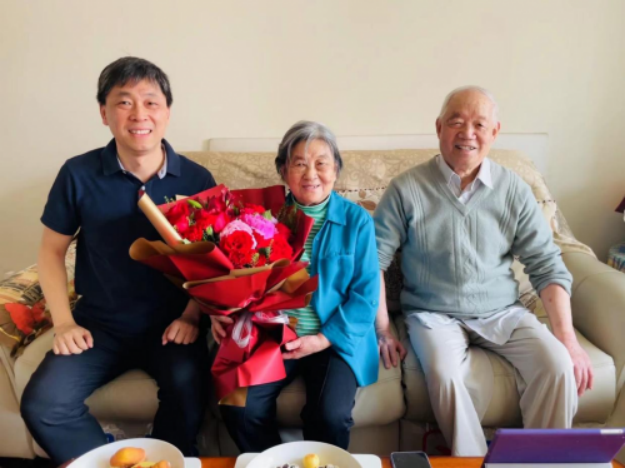
A visit to his mentor Professor Wu Weihan (on the right) on a Teachers’ Day
Looking to the Future, the Road Ahead is Challenging
He often poses a question to his graduate students, “What similarities exist between our research and fashion design?” He states, “Fashion design leads clothing trends, and an important significance of research lies in guiding the future development of technology.” This serves as a profound commentary on his current research endeavors. Research encompasses various fields, and Professor He says, “As an engineering teacher, in this era of rapid and ever-changing technological advancements, core technologies are often beyond the scope of a single discipline’s knowledge. We should have the ability to rapidly learn from different disciplines, integrate knowledge from multiple disciplines to achieve breakthroughs in key technologies. This is also the core focus of the recent construction of the new engineering disciplines. Research is endless, and learning is continuous.”
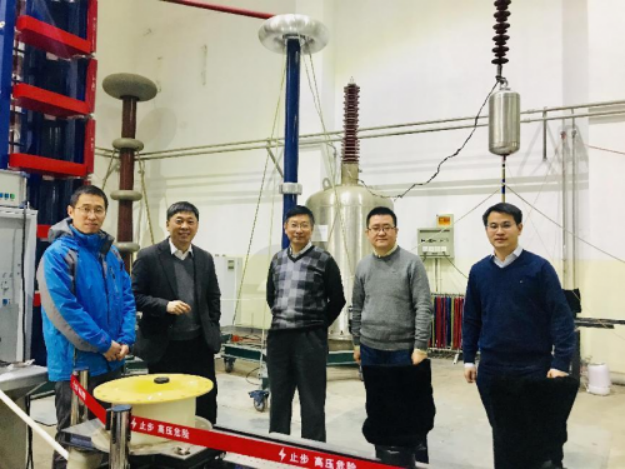
Professor He Jinliang and some teachers from the National Natural Science Foundation Innovation Research Group discussing research work
Over the years, Professor He Jinliang’s research team has grown and developed. Starting as a “lone warrior” in 1994, it has expanded into a team of 10 members. In 2019, the team was recognized as an innovation research group by the National Natural Science Foundation of China. So far, he has supervised 57 doctoral students and 50 master’s students, many of whom have become elites in various fields, including accomplished scholars in academia. Looking ahead to the future of the power industry, Professor He Jinliang says, “Firstly, breakthroughs in materials, devices, and principles will drive the leapfrog development of power energy equipment and new power systems. Secondly, the deep integration of information perception technology and artificial intelligence with the power grid will transform our national power grid into a smart giant system.” (Wu Ruixia)
Reprinted from People’s Daily · Quality News

















 Alumni
Alumni